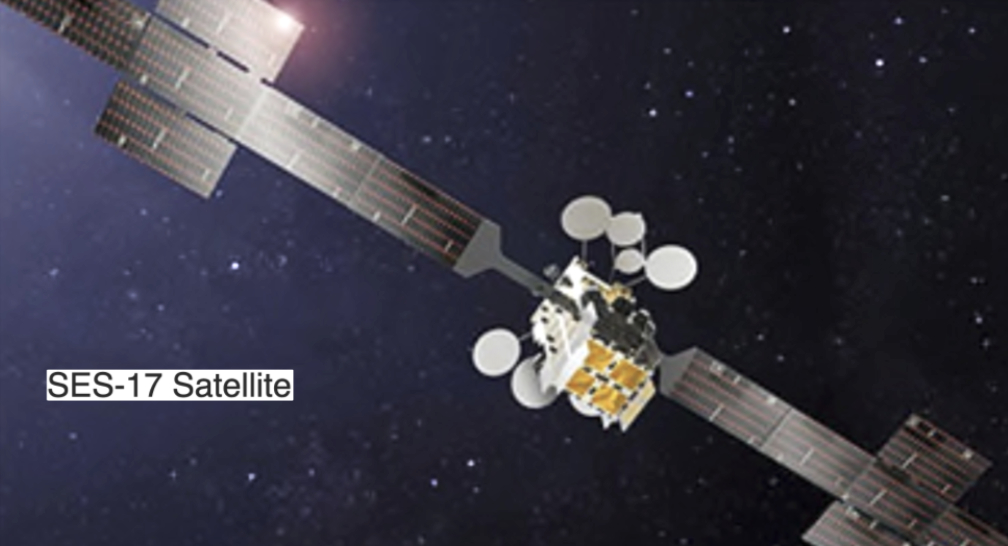
The launch of SES-17 has been delayed. Arianespace stated that investigations are ongoing in order to identify a new launch date from the Kourou spaceport.
The Ariane 5 launch vehicle and spacecraft SES-17 and fellow passenger SYRACUSE 4A are in stable and safe conditions on the launch pad, according to Arianespace. SYRACUSE-4A is a military satellite for the French defence ministry. Arianespace said that the flight, when it is rescheduled, will break previous records in terms of highest height, largest cumulative mass and heaviest payload ever carried on Ariane 5 missions.
The launch was due to take place at the Guiana Space Centre on the night of 22nd October (local time). Both satellites were built by Thales Alenia Space.

Eutelsat, in the company’s latest blog written prior to the announced departure of Rodolphe Belmer, stated that Ultra-high Definition (UHD) provides many advantages for content-makers and broadcasters and is important to the satellite industry.
One extremely important benefit in the need for UHD is in viewer retention, stated the blog. “While SDTV used to be the primary home entertainment, that quickly changed when HDTV hit the market. By 2016, only 37 per cent of US households were still watching in SD, which caused advertisers to reconsider their broadcasting choices.”
“Today,” said Eutelsat, “we’re beginning to see the same trend. According to Statista, HD TVs have been steadily losing global market share to UHD TVs since 2017. While high-resolution TV sets (4K or higher) held a 45.5 per cent market share in 2018, they accounted for over half of all TV sales worldwide in 2019. Indeed, in a recent study by Gfk, UHD TVs accounted for 75% per cent of the overall TV market in Germany.”
Broadcasters who do not want to lose viewers and protect their retention rate should seriously consider adopting UHD sooner, rather than later. This will help them avoid becoming irrelevant in much the same way as the switch from SD to HD, adds Eutelsat.
“According to a recent webinar with IABM & Christiano Benzi, UHD sets are well deployed in the market – but are not yet popular among broadcasters. Despite almost 50 per cent of TV sets in Europe and over 50 per cent in the US being UHD compatible, most channels are still broadcast in SD and HD formats. There is a clear reluctance on behalf of most broadcasters who see the investment to be too costly. However, this is sure to change – as more sets become enabled, consumer demand for quality rises. As observed with HD vs SD viewing, viewers naturally gravitate towards better quality and soon avoid other channels that cannot match their standards,” writes Eutelsat.
Indeed, Eutelsat is firmly of the view that UHD viewing as the standard is simply a matter of time.
“As most broadcasters are avoiding UHD, becoming an early adopter is an excellent opportunity for broadcasters seeking a key differentiator for their channels. This will make them more appealing to viewers and advertisers alike,” suggested Eutelsat, and continued, “As far back as 2012, advertisers have begun a mass exodus from lower-quality broadcasting. Advertisers in North America are already advertising on HD channels more than SD. The same is expected to happen with UHD. Eutelsat research has shown that early adoption of HD in developing markets has directly led to an increase in revenue for broadcasters who invest in them. The early migration in developing markets towards HD increased viewership, making broadcasters who invest in HD more attractive to advertisers.
“It’s no secret that quality attracts viewers and advertisers alike. In fact, better quality has been associated with an 18% higher retention rate, with higher quality channel advertising also outperforming the same adverts on lower-quality channels. This likely indicates that advertisers will eventually migrate to UHD for greater returns than stay on HD channels. Similar to how advertisers abandoned SD for HD. UHD is an opportunity for broadcasters to get ahead of the curve and become early adopters,” added the Eutelsat blog.

An Omnibus hearing on October 20th at the Intelsat bankruptcy court, under judge Keith Phillips, which itself had to postpone adjudicating on many of the matters scheduled to be heard, was told by the judge that Intelsat’s planned confirmation of its exit plan would likely have to be delayed.
Bankruptcy Judge Keith Phillips in Richmond, Virginia, said during a virtual hearing on Wednesday that he has “serious concerns about whether this can be accomplished in four days,” implying that the extensive evidence and testimony flowing around the case might take considerably longer that four days in front of the court.
The immediate suggestion from lawyers for Intelsat and other interested parties said they would discuss the judge’s suggested postponement of the hearing from the current November 8th start date to December 2nd. Intelsat needs approval of the plan, which is a key stage to the satellite operator wrapping up its bankruptcy, which has been ongoing since May 2020. Intelsat is looking to reduce its debt-burden of more than $15 billion to nearer $7 billion.

